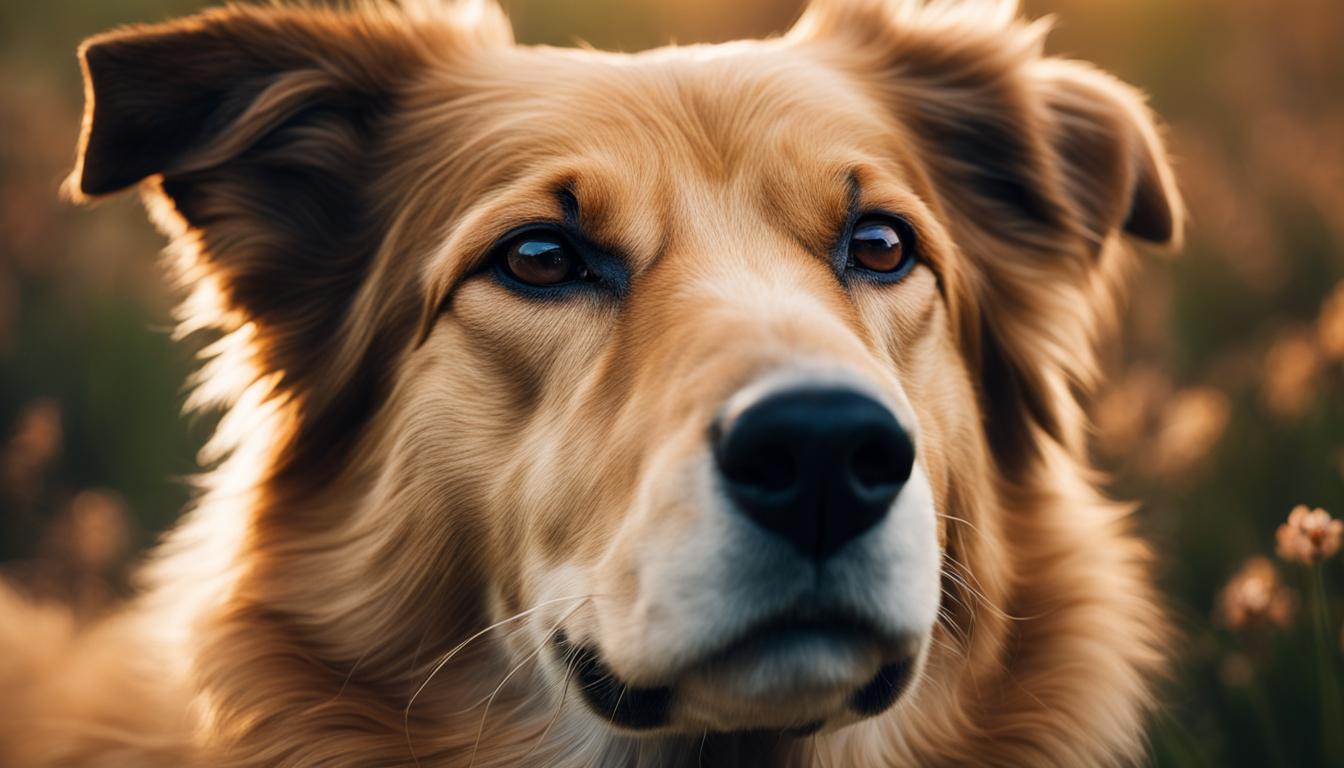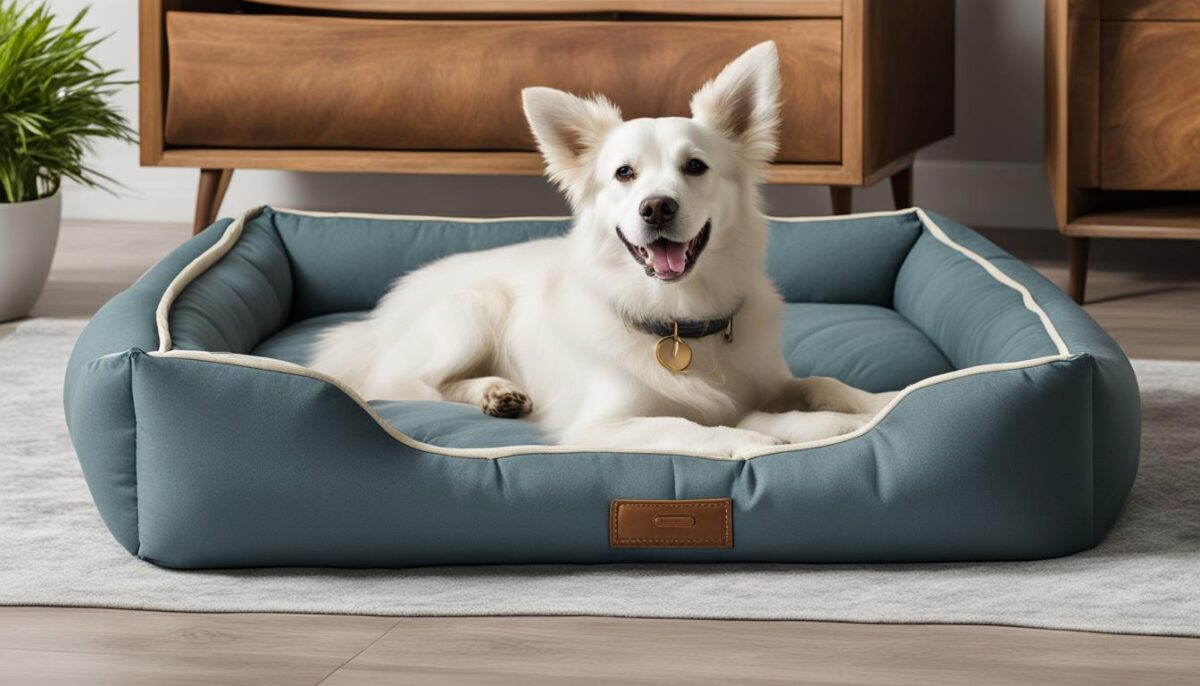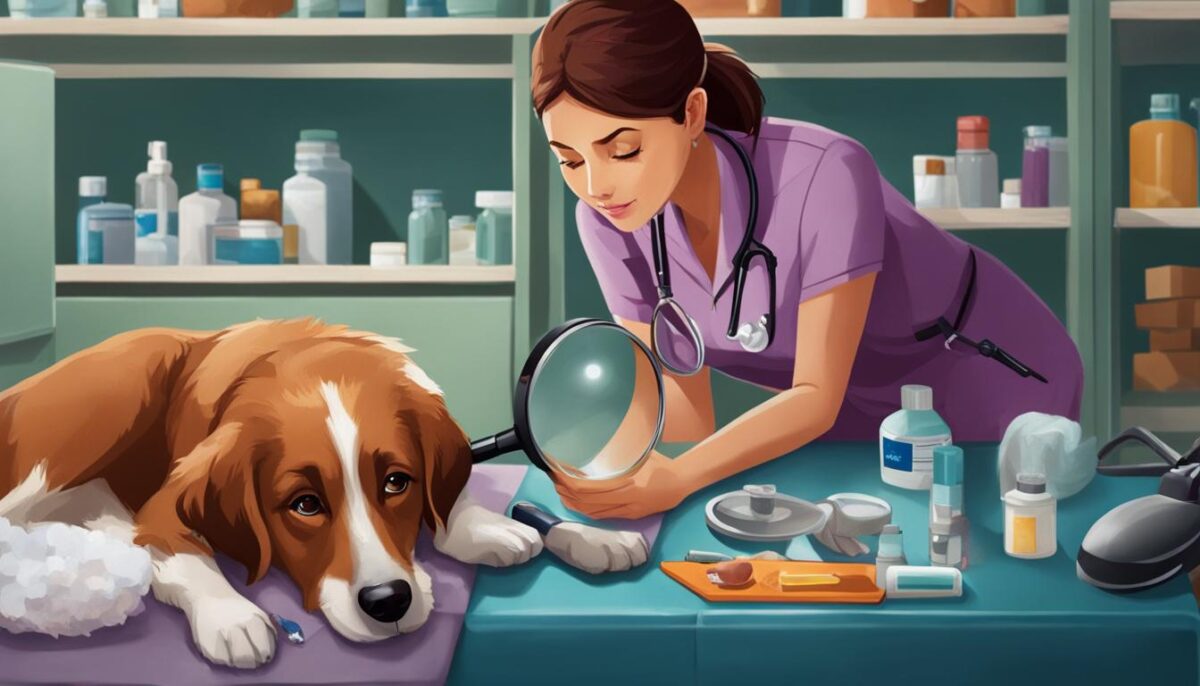Have you ever seen a spot on your dog’s skin that looks sore after they’ve been lying down a lot? Just like people, dogs can get what are called bed sores, or canine pressure sores. They happen if a dog lies in one spot for too long without moving. This is something you might see in dogs who are sick or older, and it can make them very uncomfortable. But don’t worry! There are ways to help prevent these sores and keep your furry friend’s skin looking and feeling good.
Key Takeaways
- Bed sores in dogs, sometimes called pressure sores, can happen when they lie down too much.
- These sores often show up on parts of the body like elbows or hips that don’t have much padding.
- Dog skin health is important, and caring for it can prevent these sores.
- You can help stop bed sores by giving your dog a comfy bed and checking their skin every day.
- If you see any signs of bed sores, a vet can help your dog feel better.
Understanding Pressure Sores in Dogs
If you’ve ever been in one spot for too long, you may have felt a little sore. Dogs can get these kinds of ouchies too, called pressure sores, or decubitus ulcers. These sore spots happen when a dog lies down for a long time without moving, which can squash their skin and hurt. Imagine sitting on a hard seat all day; something like that can happen to your dog!
What Are Pressure Sores and How Do They Form?
Pressure sores in dogs are areas where their skin has been injured because they’ve been lying down in one place for a really long time. Think about your elbows or hips and how bony they are. Dogs get these sores on similar spots, especially if they’re sick or can’t move around much because of something like IVDD (a kind of back problem) or paralysis (when they can’t move parts of their body).
Recognizing the Early Signs of Bed Sores in Dogs
Even before we can see a sore spot, a dog might show some signs that one is coming. Early signs include hair loss where the bones are closer to the skin, like the hips or elbows. Their skin might get red, and you may see some cracks, and they might lick the same spot a lot because it bothers them. If you see this happening, it means it’s time to see a vet quick, because catching it early can help your dog avoid getting a really bad sore.
To help your furry friend, here’s a simple list of tips for dog pressure sore prevention:
- Check on your dog’s skin every day, especially on bony parts.
- Make sure your dog has a soft bed to lie on—this can help a lot!
- Move your dog around if they can’t move much on their own.
- If you notice any signs like red skin or hair loss, visit your vet.
Remember: A happy dog is a moving dog. Keep those paws and tails wagging, and help your dog avoid those pesky pressure sores!
Risk Factors for Bed Sores in Canine Companions
Just like people, our furry friends can run into problems if they don’t move around enough. This could happen to senior dogs, pups that are paralyzed, or those dogs recovering from surgery. So, what makes these dogs more likely to get these ouchies called bed sores?
Older dogs may not move as much because their legs and body are a bit worn out. They could have a harder time getting up or might feel aches when they move. When older pups stay still for too long in one spot, they might get a sore spot.
Paralyzed dogs also don’t move a lot. They might want to get up and play, but their legs just don’t work right. These buddies need us to help them change spots so they don’t hurt their skin.
And, don’t forget the pups that just had a trip to the vet! Dogs recovering from surgery need lots of rest. But too much lying down after surgery can mean bed sores, so watch them carefully.
Here’s a table to show us what to keep an eye on so our doggy pals don’t get these bed sores:
| Type of Dog | Why They Are At Risk | What You Can Do |
|---|---|---|
| Senior Dogs | Moving around is tough due to age | Help them with soft beds and gentle exercise |
| Paralyzed Dogs | Can’t move their legs well or at all | Turn them to different sides regularly |
| Dogs Recovering from Surgery | Need to rest and might stay in one spot | Arrange comfy spots and encourage light movement |
So, for our puppy pals who are growing silver fur, those who can’t scamper about, or those taking a long nap to heal from surgery, let’s keep their cozy spots plush and shift them around so their skin stays as happy as their tails!
Can Dogs Get Bed Sores: Causes and Commonalities in Affected Dogs
Have you ever wondered why your furry buddies might get bed sores? Just like in people, one big reason is because they’ve been staying in one place for too long without moving. This can be a problem for dogs who are not feeling well or getting older. Sometimes, dogs have trouble moving around just like us when we hurt our leg or don’t feel strong. Being still for too long isn’t good because it makes it hard for blood to reach the skin. Our doggy pals need blood to keep their skin healthy. Without it, they might get a sore spot.
It’s also tougher for big dogs or dogs who are very thin to stay away from bed sores. They don’t have enough cushioning over their bones. And dogs who like to nap on hard floors? They need to be careful too! Soft, comfy beds are very important to help prevent these sores.
Let’s take a look at what can cause these pressure sores in our four-legged friends, especially those who find it hard to move around.
| Causes of Pressure Sores in Dogs | Why It’s a Problem |
|---|---|
| Being Immobilized | When dogs can’t move, their skin gets squished against the floor, which can lead to sores. |
| Long Periods of Lying Down | Staying down for hours means less blood flow and more chances for sores to develop. |
| Old Age | Older dogs move less and their skin isn’t as healthy, which makes it easier for sores to start. |
| Lack of Fat or Muscle | Skinny dogs don’t have much padding over their bones, so they’re more at risk for sores. |
| Hard Sleeping Surfaces | Hard floors can be tough on doggy skin, leading to sore spots when lying down for naps. |
Remember, keeping your dog cozy and able to move is key. If your dog can’t move much by themselves, helping them shift positions and giving them a soft place to lie can do a world of good!
Maintaining Your Dog’s Skin Health to Prevent Sores
When you want your dog to be happy and healthy, taking care of their skin is super important. Just like you love a comfy pillow to rest your head, your dog needs a cozy spot to lie down and dream sweet dreams. This not only makes them feel pampered but also keeps those nasty bed sores at bay.
Choosing the right kind of proper dog bedding plays a big role in their health. Think of an orthopedic dog bed as a superhero for your dog’s skin. It’s kind of like a memory foam mattress that shapes to their body, giving them a gentle hug while they nap. This helps ward off pressure sores and keeps their skin looking as smooth as a puppy’s!
Choosing the Right Bedding for Pressure Relief
A good bed isn’t just soft; it’s also big enough for your dog to stretch out and change positions. That’s how you can tell it’s a proper dog bedding. We’re not just talking about a pile of old blankets. Nope, it’s much smarter. The best pick is a bed that pampers those little elbows and hips.
Daily Inspections and Hygiene
Just like you brush your teeth every day, your dog needs a daily check-up too. You need to be a detective and spot any signs of trouble on their skin. If you see any icky spots or if your pup had an accident, it’s cleaning time! Keeping up with pet skincare means your furry friend will always look and feel amazing. Cool, right?
Proactive Measures to Protect Your Dog From Pressure Ulcers
As a loving pet owner, you’ll want to do everything you can to prevent your dog from uncomfortable bed sores. It’s all about keeping things moving and making sure your furry friend is well-fed and hydrated. Let’s dive into some simple tips that can make a big difference.
Reposition Your Dog Regularly
Changing your dog’s position every few hours is like giving their body a little vacation. It helps move their weight around so no one spot gets too much pressure. It’s one of the best ways for preventing dog bed sores.
The Importance of a Nutritious Diet and Hydration
Like a secret superhero, canine nutrition and hydrating pets can keep their skin super strong. A healthy diet packed with all the right stuff can help heal and fend off those pesky sores. And, giving your dog plenty of water keeps their skin from getting too dry.
| Meal Time | Nutritious Picks | Hydration Helpers |
|---|---|---|
| Breakfast | High-quality kibble with a scoop of pumpkin | Fresh water bowl refill |
| Lunch | Cooked chicken and brown rice | Water fountain for sipping |
| Dinner | Lean beef and veggies | Ice cubes for playful hydration |
With these easy switches in their daily routine, your dog will be on track for a healthy, sore-free life. And remember, a little love goes a long way!
Treating Existing Bed Sores in Dogs
If you find that your dog has a bed sore, it’s a sign they need some extra love and care. The first step is always to go see your vet, because they know how to treat these ouchies best.
When to Seek Veterinary Care
If your dog’s skin looks hurt or they seem to be in pain, it’s time to visit the vet. Early sores may just need a softer bed and more attention to heal. But if a sore looks deep, has bad stuff coming out, or isn’t getting better, your vet might say your pup needs special veterinary care for bed sores.
Available Treatments: From Antibiotics to Surgery
Sometimes, your dog’s sore might need medicine to help with the healing. If it’s a really big sore, they might even need a little surgery to get better. The table below shows some ways vets help dogs heal from pressure sores.
| Treatment | Why It Helps | When It’s Used |
|---|---|---|
| Soft Bedding | Gives cushioning to sore spots | For all bed sores |
| Medicines | Fights germs | Infected sores |
| Bandages | Keeps sores clean and protected | Sores that are healing |
| Surgery | Removes dead skin, helps healing | Very serious sores |
To help your pal the most, keep them from licking their sore because that could make it worse. Your vet will keep an eye on the sore, too, by taking pictures to see how it’s changing. Always remember that the best dog pressure sore treatment is what helps your dog feel good and happy again.
Special Considerations for Aging and Incontinent Dogs
When you have aging dogs or those who have trouble holding their pee or poop, you need to take extra special care to keep their skin safe. Wet skin from pee can make it easier for your dog to get bed sores. But, don’t worry! There are things you can do to help your furry friend stay dry and happy.
A good bed is like a cozy cloud for your dog. It lets their skin breathe and doesn’t hold onto wetness. This helps a lot in preventing bed sores in older dogs. Also, if your dog uses diapers, change them often. This keeps their skin dry and helps them feel better.
Keeping your dog on the move is also very important. Even a little move can make a big difference. And if your pooch needs help walking, a harness or a lift is like giving them a helpful hand.
| Care Item | Description | How It Helps |
|---|---|---|
| Airy Beds | Beds that let air flow | Prevents dampness and protects skin |
| Diapers | Special diapers for dogs | Keeps your pet dry and avoids irritation |
| Movement Aids | Harnesses or lifts for dogs | Helps in moving and reducing pressure on skin |
| Protective Creams | Creams to soothe skin | Creates a barrier to protect against wetness |
Remember to keep your incontinent pet care routine simple and loving. A little comfort and care can make your dog’s golden years shine brighter!
Conclusion
When you have a dog that doesn’t move around very much, you need to be a bit like a detective. Keep a close eye on their skin every day for any signs of bed sores. It’s big trouble for them if you don’t. But don’t worry, you can do a lot to prevent and manage these sores. Make sure your furry friend has a comfy and cushy bed to lie on, and help them move around if they need it. Sort of like fluffing the pillows for someone you care about, right?
Helping your dog stay comfy and happy means you need to do a few things — think of them as special missions. Number one: check their skin all the time. Number two: give them a soft spot to rest. And finally, number three: move those little paws if they can’t do it themselves. This keeps the blood flowing and their skin looking good.
If you ever see a sore spot on your dog, or if they don’t seem to feel right, get on the phone to the vet — your dog will be so glad you did. The vet can check out your dog and tell you exactly how to make things better. With some love and the right care, you’re on your way to being a super hero for your tail-wagging pal, especially when it comes to dog bed sore management and caring for a mobility-challenged dog.
FAQ
Can dogs develop pressure sores and why would they?
Yes, dogs can develop pressure sores from lying down for extended periods without moving, which puts constant pressure on certain parts of the body, leading to skin damage.
What parts of a dog’s body are most susceptible to bed sores?
Bed sores in dogs are mostly likely to form over bony areas like hips, elbows, and sides, where the skin is thinner and more vulnerable to pressure.
How can I recognize if my dog is developing a pressure sore?
Early signs of pressure sores in dogs include hair loss around bony areas, reddened skin, cracking, and frequent licking at a specific spot. If you notice any of these, contact your vet promptly.
What factors increase the risk of bed sores in dogs?
Senior dogs, paralyzed dogs, large breeds, and dogs with health issues such as arthritis or hip dysplasia are more prone to bed sores due to difficulty moving and reduced activity.
What can I do to maintain my dog’s skin health and prevent pressure sores?
To maintain dog skin health, provide a comfortable and supportive orthopedic bed, keep your pet’s skin clean and dry, and check regularly for signs of pressure sores or skin injury.
Why is it important to reposition my dog regularly?
Repositioning your dog regularly helps to redistribute weight and relieve pressure on sensitive areas, thus preventing the formation of bed sores.
How does nutrition and hydration play a role in preventing pressure ulcers in dogs?
A nutritious diet and proper hydration are essential for maintaining healthy skin and promoting wound healing, which can prevent and treat pressure ulcers in dogs.
When should I seek veterinary care for my dog’s bed sore?
Seek veterinary care at the first sign of a pressure sore, as early intervention can prevent complications and ensure proper treatment, potentially including antibiotics or surgery.
Are there special considerations for preventing pressure sores in older or incontinent dogs?
Yes, older and incontinent dogs require additional attention to skin care, such as keeping their skin dry and clean, using absorbent pads, and ensuring they have a breathable environment to rest in.


